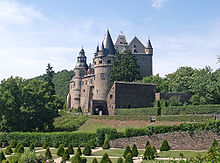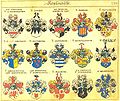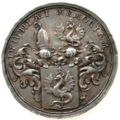Breidbach (noble family)
The Lords of Breidbach rarely also Breitbach , and finally Baron von Breidbach zu Bürresheim , were mentioned for the first time in the 13th century. A knight named Heinrich von Breidbach, whose father Randolf had just died, was appointed Ministeriale (servant) of Count Heinrich III, who died in 1247 . listed by Sayn .
Even if the sex in Siebmacher's coat of arms of 1605 in the department of the Rhineland knightly nobility as v. Breidenstein gen. Bredenbech is called, there is no kinship with the Hessian Gender Breidenbach to Breidenstein .
history

Part of the estate of Heinrich III. von Sayn (including the possessions and goods in Unkel and Rheinbreitbach ) passed to his nephew Johann von Sponheim , who was a son of Heinrich's sister, Adelheid. On April 1, 1264, he sold the properties in Rheinbreitbach and Unkel for 900 marks to Archbishop Engelbert of the Archbishopric of Cologne . Since then, the lords of Breidbach were feudal people of the Archbishopric of Cologne. The family's ancestral home is the Untere Burg (Rheinbreitbach) , which remained in the family until 1797 and was demolished in the 1960s.
There is a similarity between the coat of arms of the Lords of Breidbach and that of the Burgraves of Drachenfels , also ministerials from the Electorate of Cologne. The coat of arms of the Drachenfelser shows a silver dragon with golden fangs on a red background, that of the Breidbach shows a red dragon on a silver background. Some historians therefore suspect that the lords of Breidbach descended in some way from the burgraves of the Drachenfels due to the similarity of the two coats of arms.
The fortunes and possessions of the Lords of Breidbach grew over the next few centuries and were a product of the clever marriage, purchase and lending tactics. Thus they could build on rich income from the Mainz, Trier and Cologne areas. The family enjoyed the peak of their property and thus their reputation in the 15th century. This large and rich inheritance passed to Paul I and then to his sons Wilhelm and Gerlach. Gerlach married a rich Bonn woman, named Mase Saneck von Waldeck, who brought an enormous fortune from the archbishopric of Mainz into the marriage as a dowry .


With this fortune, knight Gerlach von Breidbach bought part of the castle and the glory of Bürresheim Castle near Mayen on May 18, 1473 via Kuno von Schöneck . This half of the Bürresheim Palace was part of the fiefdom of the Electorate of Cologne . The old lords of Bürresheim already had the Burg Bürresheim fiefdom half from the ore monasteries Cologne and Trier . Before they died out in the 15th century, the lords of Schöneck and the lords of Leudersdorf, who were soon inherited by the lords of Lahnstein, had acquired most of their goods. The Schöneckers owned both the Trier and Cologne residents, but the Lahnsteiners apparently only owned Cologne fiefdoms. This is important for the later succession and the purchase of further parts of the Bürresheim Castle from the Breidbach family in 1659. Between 1473 and 1501, Gerlach's son, Johann III. von Breidbach the fiefs of the Trier Archbishopric from Bürresheim Castle. It was not until 1659 that the Breidbach lords acquired the entire castle through Wilhelm von Breidbach. In 1691 the family was raised to the status of imperial baron. The high point of the family history was the election of Emmerich Joseph as Archbishop of Mainz (1763–1774). This archbishop crowned Joseph II , the son of Empress Maria Theresa , as emperor. This event is even reported in Goethe's “Poetry and Truth”.
After this high point in the family history of the Barons von Breidbach zu Bürresheim, the main line of the family with the Electorate Chamberlain and Oberamtmann of Koblenz and Ehrenbreitstein, Franz Ludwig Anselm von Breidbach-Bürresheim, died out on February 21, 1796 on the run from French revolutionary troops in Bamberg was shot. Since there was no regular owner at Bürresheim Castle, the grandson of Franz Ludwig Anselm's sister Caroline Louise von Breidbach-Bürresheim, who married Count Franz Lambert von Renesse, became the heir of the Bürresheim property. Since all spiritual principalities had been abolished through secularization, the previous fiefdom of the monasteries of Trier and Cologne was also ended, and Bürresheim became the private property of the Rhineland-Belgian Counts of Renesse. The coat of arms and the title of the Breidbacher were also added to theirs. The author and entrepreneur Camille de Renesse-Breidbach came from this line of descendants .

Hubertus Freiherr von Breidbach-Bürresheim (1875–1956) inherited from his mother Marie-Wilhelmine, b. Freiin von Künsberg († 1889), Fronberg Castle in Upper Palatinate, which this in turn was owned by her mother Caroline von Spiering (1815-1859), Countess von Holnstein, married in first marriage (1831) and Baroness von Künsberg in second marriage (1837) , had inherited. The Fronberg Castle Estate had belonged to the Barons von Spiering since 1622. It has been owned by the Barons von Breidbach-Bürresheim since 1875 to this day. Hubertus' son Randolph von Breidbach-Bürresheim died in 1945 in Sachsenhausen concentration camp as one of the resistance fighters on July 20, 1944 .
Relatives


- Anton Philipp von Breidbach-Bürresheim called vom Ried (1791–1878) Major General and Member of the First Chamber of the Nassau Estates
- Emmerich Joseph von Breidbach zu Bürresheim (1707–1774), Elector and Archbishop of Mainz and Prince-Bishop of Worms (since 1768)
- Ferdinand Damian von Breidbach-Bürresheim, 1700–1707 bailiff of the Ehrenbreitstein office ; 1718 first senior bailiff of the Linz office
- Franz Ludwig Anselm Freiherr von Breidbach-Bürresheim, 1774–1797 bailiff of the Ehrenbreitstein office
- Friedrich Philipp Carl Johannes Nepomuk von Breidbach-Bürresheim (1754–1805), President of the Kurmainzer War Council and Lieutenant General Field Marshal
- Hans Jakob von Breidbach (1552–1588), lord of Bürresheim Castle
- Lucia Katharina von Breidbach-Bürresheim, 1707–1718 head of the St. Thomas Abbey
- Philipp Jakob von Breidbach-Bürresheim (1794–1845) Member of the Herrenbank of the Nassau estates
- Philipp von Breidbach-Bürresheim called vom Ried (1792–1845) Chief Ceremony Master and member of the Herrenbank of the Nassau estates
- Ludwig von Breidbach-Bürresheim, general and in 1865 co-initiator of the Waterloo monument on Luisenplatz in Wiesbaden
- Wilhelm von Breidbach-Bürresheim († 1866), Bundestag envoy to Nassau
- Randolph von Breidbach-Bürresheim (1912–1945), lawyer, reserve officer and part of the German resistance from July 20, 1944
coat of arms
The family coat of arms shows a two-legged (blue-crowned) red dragon in silver . On the helmet with the red and silver covers the dragon. (Epitaph jewelery carved in stone for St. Johann bei Mayen (16th century) as well as portal jewelery at Bürresheim Castle (17th century) shows the dragon uncrowned and the head covered with a plume of cocks on the helmet.)
The baronial coat of arms, augmented by the coat of arms of the departed Riedt, is quartered , 1 and 4 coat of arms Breidbach, 2 and 3 coat of arms Riedt. Two helmets, each with a red and silver blanket, on the first the dragon (Breidbach), the second crowned , above an open flight with the figure of the shield (Riedt).
literature
-
Genealogical manual of the nobility . CA Starke Verlag , Limburg (Lahn), ISSN 0435-2408 .
- Genealogical handbook of the baronial houses. A 5, volume 30 of the complete series, 1963, pp. 21-25 (stem series)
- Adelslexikon Volume II, Volume 58 of the complete series, 1974, pp. 86-87.
- Genealogical manual of the nobility enrolled in Bavaria. 26, 2006, pp. 80-83, 780.
- Genealogical paperback of baronial houses . Justus Perthes , Gotha 1848, pp. 48–51. ; 1859, pp. 94-95. , 1866 p.100ff
- Otto Titan von Hefner , Friedrich Heyer von Rosenfeld : J. Siebmacher's large and general book of arms . Volume II, 7th section, The arms of the Nassau nobility , Bauer & Raspe, Nuremberg 1858, p. 5. , Tfl. 5 and Tfl. 6 .
- Ernst Heinrich Kneschke : New general German nobility lexicon . Volume 2, Leipzig 1860, pp. 40-42.
- Heimatverein Rheinbreitbach (Ed.): Rheinbreitbach. Then and now. Rheinbreitbach 1974.
- Anton Joseph Weidenbach : The barons of Breidbach to Bürresheim. In: Annals of the Historical Association for the Lower Rhine. Volume 24, Cologne 1872, pp. 70 ff. ( Google Books )
Web links
- Bernhard Peter: Bürresheim Castle .
- Bernhard Peter: Epitaph Johann von Breidbach and Loretta von Schöneck in St. Martin Lorch (Rhg) .
- Johann von Breidbach and Loret von Schöneck 1500 / (1511), Lorch. Grave monuments in Hesse until 1650. (Status: October 4, 2006). In: Landesgeschichtliches Informationssystem Hessen (LAGIS).
- Pedigree of Philipp Anton Freiherr von Breidbach zu Bürresheim at monasterium.net









